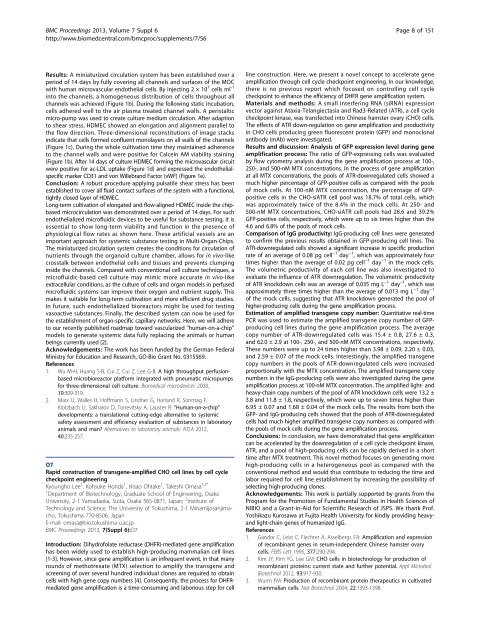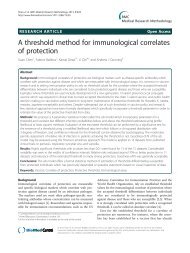Download PDF (all abstracts) - BioMed Central
Download PDF (all abstracts) - BioMed Central
Download PDF (all abstracts) - BioMed Central
Create successful ePaper yourself
Turn your PDF publications into a flip-book with our unique Google optimized e-Paper software.
BMC Proceedings 2013, Volume 7 Suppl 6<br />
http://www.biomedcentral.com/bmcproc/supplements/7/S6<br />
Page 8 of 151<br />
Results: A miniaturized circulation system has been established over a<br />
period of 14 days by fully covering <strong>all</strong> channels and surfaces of the MOC<br />
with human microvascular endothelial cells. By injecting 2 × 10 7 cells ml -1<br />
into the channels, a homogeneous distribution of cells throughout <strong>all</strong><br />
channels was achieved (Figure 1b). During the following static incubation,<br />
cells adhered well to the air plasma treated channel w<strong>all</strong>s. A peristaltic<br />
micro-pump was used to create culture medium circulation. After adaption<br />
to shear stress, HDMEC showed an elongation and alignment par<strong>all</strong>el to<br />
the flow direction. Three-dimensional reconstitutions of image stacks<br />
indicate that cells formed confluent monolayers on <strong>all</strong> w<strong>all</strong>s of the channels<br />
(Figure 1c). During the whole cultivation time they maintained adherence<br />
to the channel w<strong>all</strong>s and were positive for Calcein AM viability staining<br />
(Figure 1b). After 14 days of culture HDMEC forming the microvascular circuit<br />
were positive for ac-LDL uptake (Figure 1d) and expressed the endothelialspecific<br />
marker CD31 and von Willebrand Factor (vWF) (Figure 1e).<br />
Conclusion: A robust procedure applying pulsatile shear stress has been<br />
established to cover <strong>all</strong> fluid contact surfaces of the system with a functional,<br />
tightly closed layer of HDMEC.<br />
Long-term cultivation of elongated and flow-aligned HDMEC inside the chipbased<br />
microcirculation was demonstrated over a period of 14 days. For such<br />
endothelialized microfluidic devices to be useful for substance testing, it is<br />
essential to show long-term viability and function in the presence of<br />
physiological flow rates as shown here. These artificial vessels are an<br />
important approach for systemic substance testing in Multi-Organ-Chips.<br />
The miniaturized circulation system creates the conditions for circulation of<br />
nutrients through the organoid culture chamber, <strong>all</strong>ows for in vivo-like<br />
crosstalk between endothelial cells and tissues and prevents clumping<br />
inside the channels. Compared with conventional cell culture techniques, a<br />
microfluidic-based cell culture may mimic more accurate in vivo-like<br />
extracellular conditions, as the culture of cells and organ models in perfused<br />
microfluidic systems can improve their oxygen and nutrient supply. This<br />
makes it suitable for long-term cultivation and more efficient drug studies.<br />
In future, such endothelialized bioreactors might be used for testing<br />
vasoactive substances. Fin<strong>all</strong>y, the described system can now be used for<br />
the establishment of organ-specific capillary networks. Here, we will adhere<br />
to our recently published roadmap toward vascularized ‘’human-on-a-chip’’<br />
models to generate systemic data fully replacing the animals or human<br />
beings currently used [2].<br />
Acknowledgements: The work has been funded by the German Federal<br />
Ministry for Education and Research, GO-Bio Grant No. 0315569.<br />
References<br />
1. Wu M-H, Huang S-B, Cui Z, Cui Z, Lee G-B: A high throughput perfusionbased<br />
microbioreactor platform integrated with pneumatic micropumps<br />
for three-dimensional cell culture. Biomedical microdevices 2008,<br />
10:309-319.<br />
2. Marx U, W<strong>all</strong>es H, Hoffmann S, Lindner G, Horland R, Sonntag F,<br />
Klotzbach U, Sakharov D, Tonevitsky A, Lauster R: “Human-on-a-chip”<br />
developments: a translational cutting-edge alternative to systemic<br />
safety assessment and efficiency evaluation of substances in laboratory<br />
animals and man? Alternatives to laboratory animals: ATLA 2012,<br />
40:235-257.<br />
O7<br />
Rapid construction of transgene-amplified CHO cell lines by cell cycle<br />
checkpoint engineering<br />
Kyoungho Lee 1 , Kohsuke Honda 1 , Hisao Ohtake 1 , Takeshi Omasa 1,2*<br />
1 Department of Biotechnology, Graduate School of Engineering, Osaka<br />
University, 2-1 Yamadaoka, Suita, Osaka 565-0871, Japan;<br />
2 Institute of<br />
Technology and Science, The University of Tokushima, 2-1 Minamijosanjimacho,<br />
Tokushima 770-8506, Japan<br />
E-mail: omasa@bio.tokushima-u.ac.jp<br />
BMC Proceedings 2013, 7(Suppl 6):O7<br />
Introduction: Dihydrofolate reductase (DHFR)-mediated gene amplification<br />
has been widely used to establish high-producing mammalian cell lines<br />
[1-3]. However, since gene amplification is an infrequent event, in that many<br />
rounds of methotrexate (MTX) selection to amplify the transgene and<br />
screening of over several hundred individual clones are required to obtain<br />
cells with high gene copy numbers [4]. Consequently, the process for DHFRmediated<br />
gene amplification is a time-consuming and laborious step for cell<br />
line construction. Here, we present a novel concept to accelerate gene<br />
amplification through cell cycle checkpoint engineering. In our knowledge,<br />
there is no previous report which focused on controlling cell cycle<br />
checkpoint to enhance the efficiency of DHFR gene amplification system.<br />
Materials and methods: A sm<strong>all</strong> interfering RNA (siRNA) expression<br />
vector against Ataxia-Telangiectasia and Rad3-Related (ATR), a cell cycle<br />
checkpoint kinase, was transfected into Chinese hamster ovary (CHO) cells.<br />
The effects of ATR down-regulation on gene amplification and productivity<br />
in CHO cells producing green fluorescent protein (GFP) and monoclonal<br />
antibody (mAb) were investigated.<br />
Results and discussion: Analysis of GFP expression level during gene<br />
amplification process: The ratio of GFP-expressing cells was evaluated<br />
by flow cytometry analysis during the gene amplification process at 100-,<br />
250-, and 500-nM MTX concentrations. In the process of gene amplification<br />
at <strong>all</strong> MTX concentrations, the pools of ATR-downregulated cells showed a<br />
much higher percentage of GFP-positive cells as compared with the pools<br />
of mock cells. At 100-nM MTX concentration, the percentage of GFPpositive<br />
cells in the CHO-siATR cell pool was 18.7% of total cells, which<br />
was approximately twice of the 8.4% in the mock cells. At 250- and<br />
500-nM MTX concentrations, CHO-siATR cell pools had 28.6 and 39.2%<br />
GFP-positive cells, respectively, which were up to six times higher than the<br />
4.6 and 6.8% of the pools of mock cells.<br />
Comparison of IgG productivity: IgG-producing cell lines were generated<br />
to confirm the previous results obtained in GFP-producing cell lines. The<br />
ATR-downregulated cells showed a significant increase in specific production<br />
rate of an average of 0.08 pg cell −1 day −1 , which was approximately four<br />
times higher than the average of 0.02 pg cell −1 day −1 in the mock cells.<br />
The volumetric productivity of each cell line was also investigated to<br />
evaluate the influence of ATR downregulation. The volumetric productivity<br />
of ATR knockdown cells was an average of 0.035 mg L −1 day −1 , which was<br />
approximately three times higher than the average of 0.013 mg L −1 day −1<br />
of the mock cells, suggesting that ATR knockdown generated the pool of<br />
higher-producing cells during the gene amplification process.<br />
Estimation of amplified transgene copy number: Quantitative real-time<br />
PCR was used to estimate the amplified transgene copy number of GFPproducing<br />
cell lines during the gene amplification process. The average<br />
copy number of ATR-downregulated cells was 15.4 ± 0.8, 27.6 ± 0.3,<br />
and 62.0 ± 2.9 at 100-, 250-, and 500-nM MTX concentrations, respectively.<br />
These numbers were up to 24 times higher than 3.98 ± 0.09, 2.20 ± 0.03,<br />
and 2.59 ± 0.07 of the mock cells. Interestingly, the amplified transgene<br />
copy numbers in the pools of ATR-downregulated cells were increased<br />
proportion<strong>all</strong>y with the MTX concentration. The amplified transgene copy<br />
numbers in the IgG-producing cells were also investigated during the gene<br />
amplification process at 100-nM MTX concentration. The amplified light- and<br />
heavy-chain copy numbers of the pool of ATR knockdown cells were 13.2 ±<br />
3.8 and 11.8 ± 1.8, respectively, which were up to seven times higher than<br />
6.95 ± 0.07 and 1.68 ± 0.04 of the mock cells. The results from both the<br />
GFP- and IgG-producing cells showed that the pools of ATR-downregulated<br />
cells had much higher amplified transgene copy numbers as compared with<br />
the pools of mock cells during the gene amplification process.<br />
Conclusions: In conclusion, we have demonstrated that gene amplification<br />
can be accelerated by the downregulation of a cell cycle checkpoint kinase,<br />
ATR, and a pool of high-producing cells can be rapidly derived in a short<br />
time after MTX treatment. This novel method focuses on generating more<br />
high-producing cells in a heterogeneous pool as compared with the<br />
conventional method and would thus contribute to reducing the time and<br />
labor required for cell line establishment by increasing the possibility of<br />
selecting high-producing clones.<br />
Acknowledgements: This work is parti<strong>all</strong>y supported by grants from the<br />
Program for the Promotion of Fundamental Studies in Health Sciences of<br />
NIBIO and a Grant-in-Aid for Scientific Research of JSPS. We thank Prof.<br />
Yoshikazu Kurosawa at Fujita Health University for kindly providing heavyand<br />
light-chain genes of humanized IgG.<br />
References<br />
1. Gandor C, Leist C, Fiechter A, Asselbergs FA: Amplification and expression<br />
of recombinant genes in serum-independent Chinese hamster ovary<br />
cells. FEBS Lett 1995, 377:290-294.<br />
2. Kim JY, Kim YG, Lee GM: CHO cells in biotechnology for production of<br />
recombinant proteins: current state and further potential. Appl Microbiol<br />
Biotechnol 2012, 93:917-930.<br />
3. Wurm FM: Production of recombinant protein therapeutics in cultivated<br />
mammalian cells. Nat Biotechnol 2004, 22:1393-1398.

















